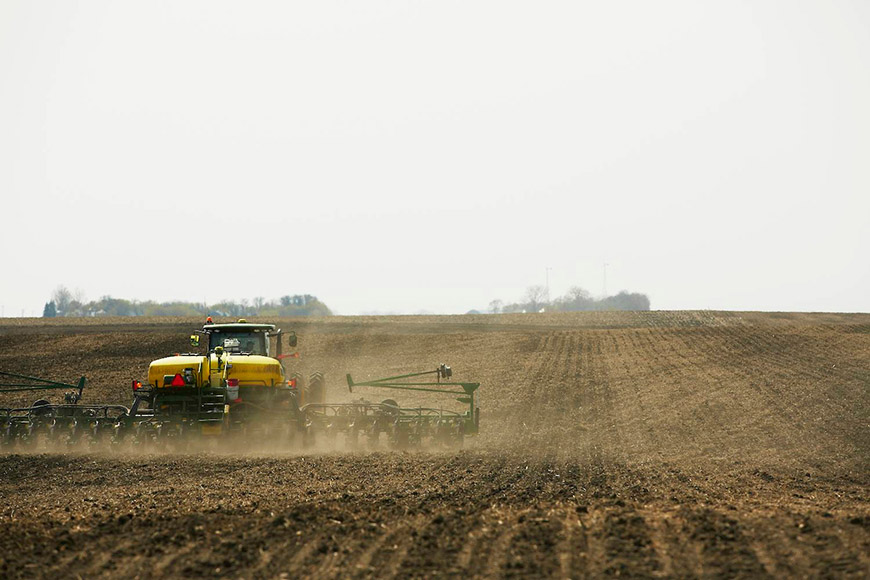Mitigate Early-Season Plant Stress

We’re gearing up for another unpredictable growing season. While we never know exactly how things will shake out at this point in the year, good management from day one is key to crop success. Here are four tips to help mitigate early-season plant stress:
1. Reevaluate seed placement and management plans. Placing seed has become more of a science because we have plenty of technology tools available to help map and model fields. High-yielding seed varieties require more intensive management. Mitigate risk when making seed choices by striking a balance between reliable, consistent performers and top-yielding genetics. Before planting, review seed ‘Response-To’ Scores for variables like planting population, nitrogen and fungicide to help fine-tune management plans based on your seed selection.
2. Don’t push planting. It’s easy to get anxious when the first warm days of spring roll around, but planting into poor soil conditions can only create problems for the rest of the season. Iowa State University reports that corn may take three weeks to emerge when soil temperatures average 50 to 55 degrees Fahrenheit at the time of planting, compared to 10-to 12-day emergence when soils average 60 degrees Fahrenheit. Plants that emerge quickly are less susceptible to root and early-season fungal diseases and to insect damage. They also tend to have more even stands.
3. Give plants a jump-start. Starter fertilizers and plant growth regulators are a good way to make sure crops have what they need for a vigorous start. Plant growth regulators such as Ascend® SL and Optify®/Stretch deliver a number of benefits to growing crops, including fueling stem elongation, stimulating sugar movement and signaling nutrient availability. Plant growth regulators can also help speed up the germination process, which is especially important if you’re planting into cool, wet soils.
2011-2013 Answer Plot® data supports the yield benefits of Ascend. Compared to untreated plots, farmers saw an average 8-bushel per acre yield advantage when Ascend was applied at planting.
*2 weeks before and 2 weeks after planting
** 2 weeks after planting
Starter fertilizers applied at planting can help stimulate root development and increase nutrient availability to small plants. Zinc and phosphorus are two nutrients that are commonly found in many starter fertilizers – both of which are vital to early plant growth and tend to be more limited when soils are wet and cool.
4. Keep an eye on fields. Scout fields early and often once plants have emerged. Taking population counts can help determine whether there were germination issues that may require extra attention. Observe plant spacing and growth stage differences between plants to evaluate whether a replant may be necessary.
Every management decision you make once the seed is in the ground can affect the number on the yield monitor at harvest. While not all plant stresses can be eliminated, there are a number of management practices that can help mitigate them.
With the growing season right around the corner, we’re here to help you with your holistic plant nutrition plan. In the coming weeks, we’ll cover split-application strategies and explain how crop modeling fits into plant health. We’ll continue to explore all aspects of plant nutrition throughout the year right here on the Growing Knowledge blog, so be sure to check back for more plant health tips.
Results may vary. Because of factors outside of Winfield Solutions’ control, such as weather, product application and any other factors, results to be obtained, including but not limited to yields, financial performance or profits, cannot be predicted or guaranteed by Winfield Solutions.
1. Reevaluate seed placement and management plans. Placing seed has become more of a science because we have plenty of technology tools available to help map and model fields. High-yielding seed varieties require more intensive management. Mitigate risk when making seed choices by striking a balance between reliable, consistent performers and top-yielding genetics. Before planting, review seed ‘Response-To’ Scores for variables like planting population, nitrogen and fungicide to help fine-tune management plans based on your seed selection.
2. Don’t push planting. It’s easy to get anxious when the first warm days of spring roll around, but planting into poor soil conditions can only create problems for the rest of the season. Iowa State University reports that corn may take three weeks to emerge when soil temperatures average 50 to 55 degrees Fahrenheit at the time of planting, compared to 10-to 12-day emergence when soils average 60 degrees Fahrenheit. Plants that emerge quickly are less susceptible to root and early-season fungal diseases and to insect damage. They also tend to have more even stands.
3. Give plants a jump-start. Starter fertilizers and plant growth regulators are a good way to make sure crops have what they need for a vigorous start. Plant growth regulators such as Ascend® SL and Optify®/Stretch deliver a number of benefits to growing crops, including fueling stem elongation, stimulating sugar movement and signaling nutrient availability. Plant growth regulators can also help speed up the germination process, which is especially important if you’re planting into cool, wet soils.
2011-2013 Answer Plot® data supports the yield benefits of Ascend. Compared to untreated plots, farmers saw an average 8-bushel per acre yield advantage when Ascend was applied at planting.
| Soil Temperature* | Answer Plot® Locations | % Positive Response Sites | Average Positive Response |
| < 50° F | 50 | 67.3 | 8.2 bu/A |
| < 60° F | 98 | 65.4 | 8.1 bu/A |
| Conditions** | % Positive Response Locations |
| < 60° F Air Temperature > 1" Precipitation |
69.2% |
Starter fertilizers applied at planting can help stimulate root development and increase nutrient availability to small plants. Zinc and phosphorus are two nutrients that are commonly found in many starter fertilizers – both of which are vital to early plant growth and tend to be more limited when soils are wet and cool.
4. Keep an eye on fields. Scout fields early and often once plants have emerged. Taking population counts can help determine whether there were germination issues that may require extra attention. Observe plant spacing and growth stage differences between plants to evaluate whether a replant may be necessary.
Every management decision you make once the seed is in the ground can affect the number on the yield monitor at harvest. While not all plant stresses can be eliminated, there are a number of management practices that can help mitigate them.
With the growing season right around the corner, we’re here to help you with your holistic plant nutrition plan. In the coming weeks, we’ll cover split-application strategies and explain how crop modeling fits into plant health. We’ll continue to explore all aspects of plant nutrition throughout the year right here on the Growing Knowledge blog, so be sure to check back for more plant health tips.
Results may vary. Because of factors outside of Winfield Solutions’ control, such as weather, product application and any other factors, results to be obtained, including but not limited to yields, financial performance or profits, cannot be predicted or guaranteed by Winfield Solutions.


